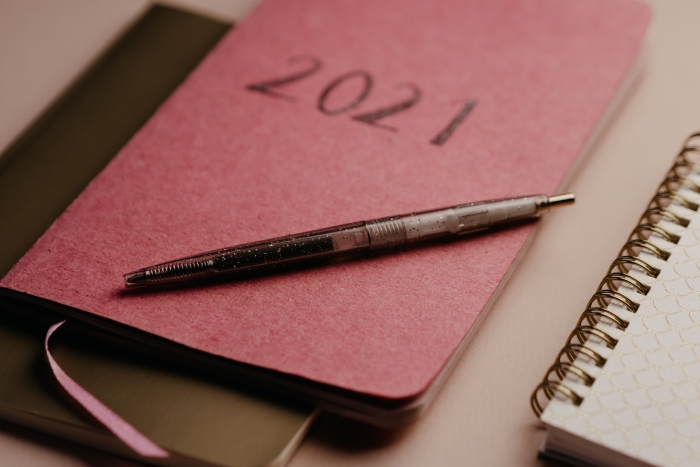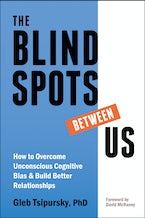By Gleb Tsipursky, PhD, author of The Blindspots Between Us
How can you understand and change biased thinking effectively? First, you need to understand what bias means.
Unconscious bias (also known as implicit bias) refers to unconscious forms of discrimination and stereotyping based on race, gender, sexuality, ethnicity, ability, age, and so on. It differs from cognitive bias, which is a predictable pattern of mental errors that result in us misperceiving reality and, as a result, deviating away from the most likely way of reaching our goals.
In other words, from the perspective of what is best for us as individuals, falling for a cognitive bias always harms us by lowering our probability of getting what we want. These mental blindspots impact all areas of our life, from health to politics and even shopping. Despite cognitive biases sometimes leading to discriminatory thinking and feeling patterns, unconscious bias and cognitive bias are two separate and distinct concepts.
Cognitive biases are common across humankind and relate to the particular wiring of our brains, while unconscious bias relates to perceptions between different groups and are specific for the society in which we live. For example, I bet you don’t care or even think about whether someone is a noble or a commoner, yet that distinction was fundamentally important a few centuries ago across Europe. To take another example—something geographic instead of one across time—most people in the US don’t have strong feelings about Sunni versus Shiite Muslims, yet this distinction is incredibly meaningful in many parts of the world.
As a frequent speaker and trainer on diversity and inclusion to address potential unconscious discriminatory behavior, I regularly share in speeches that black Americans suffer from police harassment and violence at a much higher rate than whites. Often, some participants (usually white) try to defend the police by claiming that black people are more violent and likely to break the law than whites. They thus attribute police harassment to the internal characteristics of black people (implying that it is deserved), not to the external context of police behavior.
In reality—as I point out in my response to these folks—research shows that black people are harassed and harmed by police at a much higher rate for the same kind of activity. A white person walking by a cop, for example, is statistically much less likely to be stopped and frisked than a black one. At the other end of things, a white person resisting arrest is much less likely to be violently beaten than a black one. In other words, statistics show that the higher rate of harassment and violence against black Americans by police is due to the prejudice of the police officers, at least to a large extent.
However, I am careful to clarify that this discrimination is not necessarily intentional. Sometimes, it indeed is deliberate, with white police officers consciously believing that black Americans deserve much more scrutiny than whites. At other times, the discriminatory behavior results from unconscious, implicit thought processes that the police officer would not consciously endorse.
Interestingly, many black police officers have an unconscious prejudice against other black people, perceiving them in a more negative light than white people when evaluating potential suspects. This unconscious bias shows that such prejudices come, to a significant extent, from internal cultures within police departments, rather than preexisting racist attitudes before someone joins a police department. Such cultures are perpetuated by internal norms, policies, and training procedures, and any police department wishing to address unconscious bias needs to address internal culture first and foremost, rather than attributing racism to individual officers.
The crucial thing to highlight is that there is no shame or blame in implicit bias, as it’s not stemming from any fault in the individual. This no-shame approach decreases the fight-freeze-or-flight defensive response among reluctant audiences, helping them hear and accept the issue.
With these additional statistics and discussion of implicit bias, the issue is generally settled. Still, from their subsequent behavior it’s clear that some of these audience members don’t immediately internalize this evidence. It’s much more comforting for them to feel that police officers are right and anyone targeted by police deserves it; in turn, they are highly reluctant to accept the need to focus more efforts and energy on protecting black Americans from police violence, due to the structural challenges facing these groups.
The issue of unconscious bias doesn’t match their intuitions and thus they reject this concept, despite extensive and strong evidence for its pervasive role in policing. It takes a series of subsequent follow-up conversations and interventions to move the needle. A single training is almost never sufficient, both in my experience and according to research.
It also helps to draw attention to other areas of decision-making research where we need to go against our gut to make good decisions. For example, in shopping, we can use a decision aid such as this website that reduces our choices to the top ten options so that we pay attention to the best possible choices, rather than being caught by an effective marketing message.
This example of how to fight unconscious bias illustrates broader patterns you need to follow to understand and change your bias:
1) Start by learning about the kind of problems that result from biased thinking yourself, so that you know what you’re trying to address.
2) Then, you need to convey to people who you want to influence, such as your employees or any other group or even yourself, that there should be no shame or guilt in acknowledging our instincts.
3) Next, you need to convey the dangers associated with following their intuitions, to build up an emotional investment into changing behaviors.
4) Then, you need to convey the right mental habits that will help them make the best choices.
Remember, a one-time intervention is insufficient for doing so. It takes a long-term commitment and constant discipline and efforts to understand and change your bias.
Dr. Gleb Tsipursky, PhD, is an internationally renowned thought leader who defends people from relationship disasters caused by dangerous judgment errors known as cognitive biases. He serves as CEO of the boutique future-proofing consultancy Disaster Avoidance Experts, which helps clients secure their future by forecasting and addressing people-related threats and opportunities. His cutting-edge thought leadership was featured in over 550 articles and 450 interviews in Psychology Today, USA Today, CBS News, Time, Inc. Magazine, Entrepreneur, Business Insider, Government Executive, Fortune, The Chronicle of Philanthropy, Fast Company, and elsewhere. His expertise stems from his background of over twenty years of consulting, coaching, speaking, and training on future-proofing. It also comes from his research background as a behavioral scientist with over fifteen years in academia, including seven as a professor at Ohio State University, and dozens of peer-reviewed articles published in academic journals such as Behavior and Social Issues and the Journal of Social and Political Psychology. A best-selling author, he wrote Never Go With Your Gut and Resilience. He lives in Columbus, OH; and to avoid disaster in his personal life, makes sure to spend ample time with his wife. Sign up for The Blindspots Between Us book club here.



 2024 Peace Playbook: 3 Tactics to Avoid Clashes with Your Partner
2024 Peace Playbook: 3 Tactics to Avoid Clashes with Your Partner